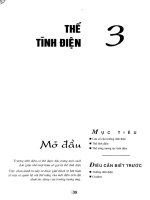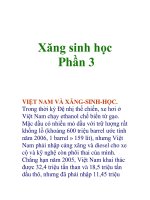Cross Modulation in CDMA Mobile Phone Transceivers phần 3 pot
Bạn đang xem bản rút gọn của tài liệu. Xem và tải ngay bản đầy đủ của tài liệu tại đây (1.15 MB, 11 trang )
21
H
•
4/17/01
Page 21
dB change
Large signal instantaneous power P
T
(t) in dB below IP3
Large signal gain
compression
Small signal
desensitization
d(t)
c(t)
Actual simulation
Variation of c(t) and d(t) with PT(t)
Simulation results for gain compresion of a large signal, and simultaneous
desensitization of a single tone small signal, are shown above, for a 3rd order
nonlinearity. The x-axis is the large signal input level relative to the input IP3,
in dB. The y-axis shows the change in gain for the large and the small signals,
in dB.
22
H
•
4/17/01
Page 22
Remove AM modulation by making d(t) = constant.
Modulate LNA gain as a
1
(t).
Total LNA gain for jammer is a
1
(t)d(t).
Equating a
1
(t)d(t) = 1, the equation for a
1
(t) is:
(i.e. gain changes with signal power)
Investigate envelope gain “E” versus Cross Mod noise power
(E=1 for cancellation of AM)
Linearization by Gain Modulation
The time varying desensitization of the single tone jammer produces spectral
spread of its power, resulting in significant increase in the receiver channel
cross mod noise. To greately reduce cross modulation, the total gain of the
jammer should be made time independent. This can be done by linearily
varying the LNA gain by the instantaneous power P
T
(t) according to the
equation above.
By doing this linear gain modulation, a
1
(t)d(t) = 1 for the optimum case when
E=1 and there is negligible AM modulation of the jammer, and so there is very
little spectral spreading.
23
H
•
4/17/01
Page 23
Gain Modulation of LNA
The proposed block diagram for the LNA linearization is shown above. In this
figure, the constant E represents the gain of the envelope power detector,
combined with the proportionality constant of the gain control of the LNA.
Ideally, the value of the envelope gain E should be one.
24
H
•
4/17/01
Page 24
Envelope Power Detectors
Models for the envelope power detector are depicted above. In a real
implementation in silicon, it may be required to have an external control to
calibrate E. Also, the instantaneous power P
T
(t) that is used for the gain
modulation, could be directly generated in the base band modem, with an
appropriate delay. Also, it is not necessary that P
J
<< P
T
for the linearization
to be effective. Even when the two powers are equal, the linearization works
well. Another problem with implementation is the detection of P
T
(t) at the
LNA output where the external filter may offer changing load in the transmit
band. It may be required to buffer the output stage or have a current tap at an
appropriate point in the LNA, for the detection of P
T
(t).
25
H
•
4/17/01
Page 25
LNA Gain Modulation in ADS
Phase
Magnitude
Gain Modulation
Nonlinear LNA
Envelope detector
Convert to
power
Scale by E/P
OIP3
IQ to Polar
Polar to IQ
IQ to RF
RF to IQ
Implementation of the LNA gain modulation in HP ADS is shown above.
At the extreme left is the LNA which models the nonlinearity, using various
possible models in HP ADS. In the present simulation, only the IP3 has been
included for the nonlinearity.
Since the simple gain modulation for linearization is only an AM modulation,
it is done on the magnitude of the RF signal in the simulation. At the output of
the LNA, the signal is split into two paths. The top path extracts the magnitude
and phase of the envelope after down converting to base band I and Q. The
lower path detects the time varying signal power P
T
(t), and constructs a base
band signal
[1 + P
T
(t)/P
OIP3
],
which is then multiplied with the magnitude information of the top path. This
AM modulated magnitude is combined with the original phase information
back into I and Q (polar to rectangular conversion). The I and Q signals are
then converted back to RF using a QAM modulator.
26
H
•
4/17/01
Page 26
LNA linearization in ADS
Transmitter
Nonlinear LNA
Output
Spectrum
TX Power
RX channel
Cross Modulation
noise power
Lowers out-of-
band
noise floor
Sweep E
Jammer
In the simulation above, the cross modulation noise power in the receive
channel is measured as a function of the envelope gain factor E. The
simulation setup is almost identical to the earlier cross modulation setup,
except that here the linearization of the LNA is performed inside the block
tagged “Nonlinear LNA.” This block is shown in detail in the previous slide.
When E = 0, there is no linearization at all, and the “Nonlinear LNA” block
simply behaves as a nonlinear gain. When E = 1, the linearization is optimum,
and the cross modulation noise is minimal.
27
H
•
4/17/01
Page 27
TX power = -23 dBm
Jammer power = -33 dBm
LNA input IP3 = 2 dBm
Simulation of Cross Mod noise vs E
For the LNA linearization investigation, a simulation was done using HP ADS
to see the effect of the envelope gain E, on the cross modulation noise power
in the receive band. The result is shown above. The LNA input IP3 was taken
as 2 dBm, the transmitter power leakage into the LNA was taken as -23 dBm,
and the single tone jammer power was -33 dBm. According to the earlier
derived cross modulation noise model for Cellular band, the cross modulation
noise power should be -86.3 dBm in the receive band without linearization i.e.
for E = 0. In the above figure it can be seen that the cross modulation power
varies between -86.3 dBm (for E = 0) and -113 dBm (for E = 1). The simulator
noise floor gave -116 dBm cross modulation noise power with no LNA
nonlinearity.
28
H
•
4/17/01
Page 28
TX leakage
Jammer
Cross Mod noise
(no linearization)
With linearization
LNA input
dBm
in 30 kHz
Spectrum showing LNA linearization
The simulated spectrum for the LNA cross modulation with (E = 1) and
without (E = 0) linearization, is shown above. It can be visually seen from this
spectrum how significantly linearization reduces the cross modulation noise
power. Simulations were also done to investigate exponential gain modulation
from the envelope (gain in dB linearly varying with envelope voltage), but the
results were comparatively inferior.
Effect on Received CDMA Signal
The desensitization due to cross modulation also occurs on the wanted
signal which is extremely small in comparison with the transmitter
leakage power. It slightly degrades the orthogonality of the Walsh
channels and degrades the despread S/N more severely for Traffic
channels that are at relatively weaker levels compared with other
channels on the same carrier. The orthogonality is degraded slightly
because the mean gain change interval (due to desensitization) is much
less than the 64-chip symbol interval over which the orthogonality is
established. With the additional gain modulation for linearization, the
orthogonality of the received Walsh channels actually improves (even
though it may be very small), as it removes to a large extent the time
varying desensitization. This occurs independently of the presence of
jammers.
29
H
•
4/17/01
Page 29
• IS-95 Dual band triple mode LNA+Mixer specifications by Rishi
Mohindra (Philips Semiconductors internal document), August 1998.
• Dual-Band High-Linearity Variable-Gain Low-Noise Amplifiers for
Wireless Applications, by Keng Leong Fong. ISSCC99.
• Modern Quadrature Amplitude Modulation, Principles and
Applications for Fixed and Wireless Channels, by Webb and Hanzo.
• Agilent ADS documentation.
References
30
H
•
4/17/01
Page 30
ADS project: crossmod_prj
Design files:
1) CROSSMOD
Simulates LNA cross modulation noise and
spectrum
2) CROSSMOD_LINEARIZE
Linearizes the LNA and measures cross
modulation noise and spectrum. Measures Cross
Mod noise versus envelope gain E.
ADS Project and Exercise
Cross Modulation simulation:
Simulate the design CROSSMOD, and observe the input and output LNA
signal spectrum. The output spectrum has a very large cross modulation noise.
It is -86 dBm as measured by the power meter after the receive channel filter.
The ip3 of the LNA is TOI = 2 dBm, the TX leakage is -23 dBm, and the
jammer level is -33 dBm. The results are already saved in the file
CROSSMOD.dds that can be opened through the results display window.
Linearization simulation:
The linearization simulation is done in the design CROSSMOD_linearize. It is
similar to the previous simulation except that the LNA has been now included
in a linearization block. An important parameter to adjust is the envelope gain
E. When E = 0, the linearization is completely switched off, and the LNA
output signal spectrum is identical to the CROSSMOD design simulation.
When E = 1, the linearization is optimal i.e. the cross mod noise is minimal. It
can be visually seen in the output signal spectrum and accurately measured by
the receive channel power meter which reads about -108 dBm. The results can
also be seen in the display file named CROSSMOD_linearize.dds.
If the parameter sweep block is enabled, the cross mod noise can be ploted as a
function of E which is swept from 0 to 1.5. The minimum cross mod noise
occurs at E = 1. The results are also available in the display file named
CROSSMOD_Esweep.
31
H
•
4/17/01
Page 31
End of Design Seminar









